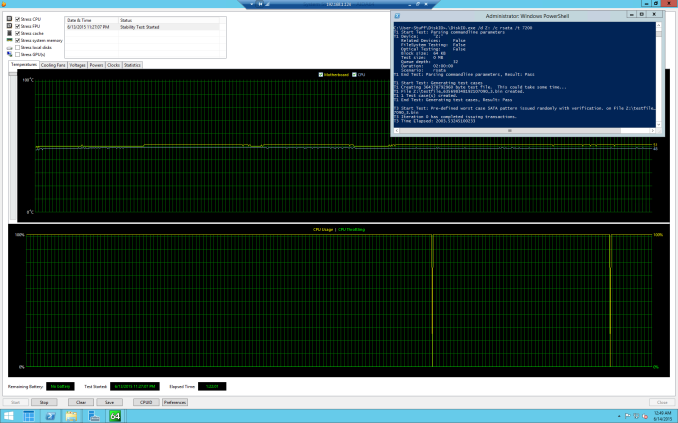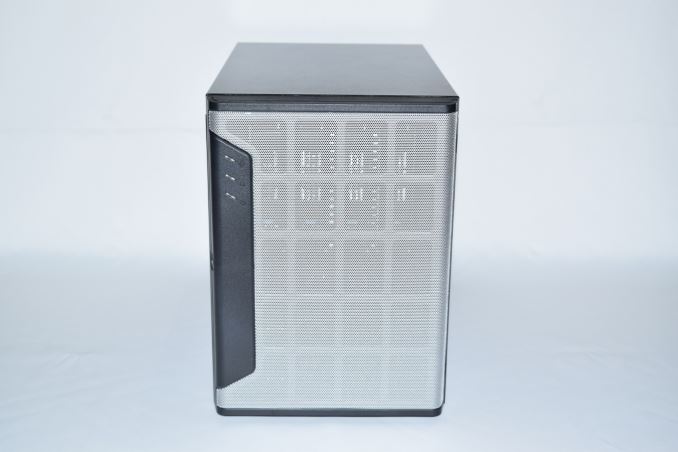Advatronix Nimbus 400 File Server Review
by Ganesh T S on August 12, 2015 8:00 AM EST- Posted in
- NAS
- storage server
- Avoton
- Advatronix
Miscellaneous Aspects and Concluding Remarks
Low power consumption and the ability to keep the drives cool under stress are some of the desirable characteristics of file servers. In order to evaluate this aspect, we subject the system with Windows Server 2012 R2 Essentials to a stability test using AIDA64. For stressing the disks (storage spaces volume using the drive bays), we used Microsoft's DiskIO with the pre-defined worst-case SATA patterns issued randomly with verification.
We find that the CPU doesn't throttle and the cores stabilize around 48 C, with the motherboard at 51 C. During this process, we also recorded power consumption at the wall. We found that the maximum power consumption was around 67 W, while the idling power consumption was around 40 W. Note that this is a 14W TDP SoC (compared to the 20W TDP version we had in the U-NAS build).
The Advatronix Nimbus 400 is the second of three file servers that we have evaluated with Ubuntu 14.04 and Windows Server / Storage Spaces. While the Phoronix Test Suite benchmarks have been chosen for their relevance to file server workloads, it appears that the SPEC SFS 2014 benchmarks do not bring out what people use the Storage Spaces feature for. We are still optimizing the testbed for SPEC SFS 2014, and we do have plans to evaluate other NAS OSes used in DIY builds using the same approach down the road.
Coming to the business end of the review, we have a few things to discuss. The chassis is solid and worthy of praise. The thermal solution is top notch and the choice of a USB 3.0 PCIe card alleviates one of the shortcomings of the Intel Avoton platform / ASRock Rack C2550D4I motherboard. Advatronix has taken care to ensure that the hot-swap bays are all connected to SATA 6 Gbps ports in the system. The only problem / complaint that one could mention here is the sharing of a PCIe 2.0 x1 link amongst four USB 3.0 ports. Performance-wise, the Intel Avoton SoC a mature and known quantity. The choice of a Windows Storage Space with simple parity is not efficient when looking at the system from a performance perspective. However, people opting for Windows Server as the OS often have other compelling reasons to do so.
The build presented in this review has a diskless cost of around USD 767. Including a license for Windows Server 2012 R2 Essentials (our review configuration) drives up the price to USD 1493. The Intel Avoton platform has proved very popular for systems with file serving and / or NAS duties. Consumers considering the Avoton option (either build or purchase) would do well to take a closer look at the Advatronix Nimbus 400.












18 Comments
View All Comments
lwatcdr - Wednesday, August 12, 2015 - link
I would really like to see some data using FreeNAS and Windows as well as Ubuntu. With the cost of drivers so low both of the NAS systems offer a huge amount of data for home or business.wintermute000 - Thursday, August 13, 2015 - link
nowhere near enough free RAM for Freenas. 1Gb per Tb is the recommendation. With modern drives @ even RAIDZ1, you do the mathwintermute000 - Thursday, August 13, 2015 - link
Sorry, no idea why but I read it as 4Gb not 4x4Gb, my badBrutalizer - Sunday, August 16, 2015 - link
For zfs, it is recommened to use 1GB ram per 1TB disk space - only if you use deduplication. If not, 4GB in total is enough. Zfs has a very efficient disk cache, if you only have 2GB ram in your server you will not any disk cache, which is no big deal actually. Myself used 1GB ram server for a year with solaris and zfs for a year without problems. Lot of ignorance about zfs. Try it out yourself with 2-4 GB ram server and see it will work fine.DanNeely - Wednesday, August 12, 2015 - link
Aside from the front panel having USB3, this case looks identical to one I bought from Chenbro a few years ago for my DIY nas. I'd be a bit concerned about the quality. The plastic locking half of the handle on one of the drive sleds popped when I pulled it out a month or two ago to add an additional drive to my setup. The metal half was still usable to pull the drive out and it appears to be held in place securely from the rear; but the normal latch mechanism is obviously not working any more.Anonymous Blowhard - Wednesday, August 12, 2015 - link
I'm concerned about the presence of a Marvell SATA controller + FreeBSD based OS like FreeNAS, since there's been many reports of drives performing poorly or dropping out of ZFS pools under high I/O.bobbozzo - Friday, August 14, 2015 - link
Remove USB card and insert IBM 1015 RAID card. Hope cabling is compatible.SirGCal - Wednesday, August 12, 2015 - link
I personally have two 8-drive, one RAID6 and one RAIDZ2, both running Ubuntu. Both of them also run swifter then this. Curious.Ratman6161 - Wednesday, August 12, 2015 - link
Data is a little stilted because the Asrock is using an 8C 2750 vs the 4 C in the Advantronix - so anything CPU sensitive is not really fair - particularly since the Advantronix is available with the 8C CPU.That said, I sort of doubt many people will be running DB's on this sort of machine. And the other tests seem to indicate that the faster CPU doesn't really buy you anything.
And...4 SSD's in a RAID 5? The cost per GB for doing things that way is very high compared to spinning disks and if its being used in a home setting the performance of the SSD's is not needed. comparing prices online I could get 4x WD Black 750 GB drives for almost $100 cheaper than the 4 x 128 GB Vectors. Take a look at the read performance of the two units. Theoretically the Asrock with an 8 drive array should get better read speed than the Nimbus 400 with only 4. But it doesn't leading me to believe that a lot of the SSD's performance is wasted. Spinning disks is probably the most cost effective way to go with these.
lwatcdr - Wednesday, August 12, 2015 - link
Encryption uses up a good amount of CPU time.